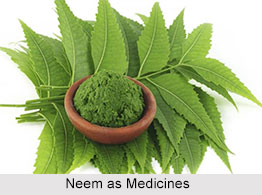 Azadirachta Indica, also known as Neem is useful tree is indigenous to India and is cultivated all over the country for the sake of its bark, leaves and fruits. These have been used in Hindu medicine from a very remote period. Neem is used in so many ways in herbal medicine, which is why it has been tagged the "Village Pharmacy".
Azadirachta Indica, also known as Neem is useful tree is indigenous to India and is cultivated all over the country for the sake of its bark, leaves and fruits. These have been used in Hindu medicine from a very remote period. Neem is used in so many ways in herbal medicine, which is why it has been tagged the "Village Pharmacy".
Health Benefits of Neem
The bark of Neem is regarded as bitter, tonic, astringent and useful in fever, thirst, nausea, vomiting and skin diseases. The bitter leaves are used as a pot-herb being made into soup or curry with other vegetables. The slightly aromatic and bitter taste which they impart to the curries thus prepared is much relished by some. The leaves are moreover an old and popular remedy for skin diseases. The fruits are described as purgative and emollient and useful in intestinal worms, urinary diseases, piles etc. The oil obtained from the seeds is used in skin diseases and ulcers.
Dose of Neem in Medicine
The bark is used in fever in combination with other medicines for this disease as for example, in the following compound decoction called Amritashtaka. Take neem bark, gulancha, root of Picrorrhiza Kurroa (katuki), tubers of Cyperus rotundas (mustaka), seeds of Holarrhena antidysenterica (indrajava), leaves of Momordica dioica (patala), ginger and red sandal wood, each quarter of a tola and water half a seer, boil till reduced to one-fourth. This decoction is given with the addition of honey and long pepper in fever supposed to be caused by deranged phlegm and bile and attended with vomiting, nausea, thirst and lassitude.
The fresh juice of the leaves is given with salt in intestinal worms, and with honey in jaundice and skin diseases. The juice of neem leaves and of emblic myrobalans, quarter of a tola each, is recommended to be given with the addition of clarified butter in prurigo, boils and urticaria.
Neem enters into the composition of several compound preparations used in skin diseases, such as the Pancha Tikta Ghrita, Pancha Nimba Gudika, Pancha Kashaya, etc.
Pancha Tikta Ghrita: Take neem bark, leaves of Momordica dioica (patala), Solanum Jacquinii (kantakari), gulancha, and bark of Adhatoda vasica (vasaka), each 80 tolas, and boil them in 64 seers of water till it is reduced to one-fourth. To the strained decoction, add 4 seers of clarified butter and a seer of the 3 myrobalans in the form of a paste, and prepare a ghrita in the usual way. This preparation is given in doses of 3 to 6 drachms in chronic skin diseases
As an external application to ulcers and skin diseases, neem leaves are used in a variety of forms such as poultice, wash, ointment and liniment. A poultice made of equal parts of neem leaves and sesamum seeds are recommended by Chakradatta for unhealthy ulcerations.
The following preparation of nim oil is prescribed by several writers for application to suppurating scrofulous glands with numerous openings. Take the oil of neem seeds 4 seers; orpiment, realgar, marking nut, cardamoms, aloes wood, sandal wood, leaves of Jasminum grandiflorum (jatipatra) and Limnanthenum cristatum (tagarapaduka), each 8 tolas in the form of a paste and water 16 seers. Boil them together and prepare an oil in the usual way.
Related Articles
Ayurveda
Ayurveda Medication
Elements of Ayurveda
Concepts of Ayurveda
Ancient Literature of Ayurveda





